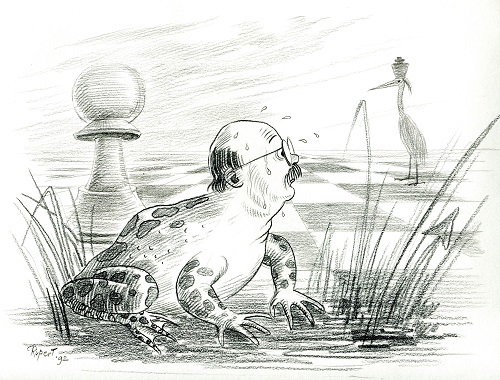
A ‘Burgundian’ in word and deed
‘Never let the truth get in the way of a good story.’ If there was one saying in journalism that applied to Lex Jongsma, it was this one. Is there any chess player of the forty-plus generation who doesn’t know Jongsma? For decades he gave commentary at chess tournaments, with Wijk aan Zee as the annual high point. The audience would eat out of his hand, especially because of the juicy way in which he dished up his anecdotes. Sometimes people forgot that he was also pretty good as a chess player.
His stories were certainly juicy, but were they always truthful? Well… no. Not when he was telling them while improvising before a large audience, but neither when he had more time to conceive them. For example, in an issue of the Dutch magazine Matten he wrote, in an article on Lodewijk Prins, about how he was waiting together with, among others, Euwe, Prins, Donner and Cortlever at the Zestienhoven airport in Rotterdam for his flight to England, where he, Jongsma, was going to play his first international match. Alas, Euwe, Donner and Prins didn’t even compete in this match – though Cortlever did.
Let’s try to make this not too negative a story. Lex Jongsma has contributed a lot to the efforts to make chess accessible to a larger public. He did so as a commentator, but probably even more as a correspondent for De Telegraaf. From 1968 to 2008 (for forty years!) he wrote for this newspaper – first together with Carel van den Berg, who initially kept writing the weekly column, and, after the latter’s demise in 1971, on his own. Already one year later, there was a hard nut for Jongsma to crack: the Fischer-Spassky match.
For people who witnessed it, the way he sent his reports to the newspaper was legendary. Lex could not work with a typewriter, and neither could he operate a computer later on. When he had his story ready, he called the paper’s shorthand typists and dictated the text, including the chess moves, from memory. It can’t have been easy for the ladies – it was always ladies – on the other end of the line. The following sentence, which we found in his first column in 1971, is characteristic for his style:
‘In order to strive for some organization in the plenitude, I propose to you, now that for the first time – greetings, reader! – I call your attention to something that is supposed to grow out to be a chess column that is to be just as genuine as the unforgettable Carel van den Berg used to make for you, a couple of things – by way of a non-binding programme.’
How strong was Jongsma as a chess player? Today, we would say that he could have become a good master. But then his study came first, and then his job and wife and children. He did become a master, yes – but in law.
Perhaps his best result was his third place in the Junior World Championships in 1957, after having become Dutch Junior Champion earlier that year. He participated in the Dutch Championship three times, played for the Dutch team ten times, and took part twice in the Grandmaster group of the IBM tournament, making draws, among others, with top players like Bronstein, Gligoric and Ivkov.
Besides very many other activities, like writing chess books and organizing chess activities, Jongsma should definitely be remembered as the inventor of the annual tournament in Hoogeveen. I myself remember him as the creative chairman of the editorial commission of the Dutch federation’s SchaakMagazine. After our meetings, it would always be time for copious meals and drinks. For, most of all, Jongsma was a Burgundian in everything he did. (MbdW)